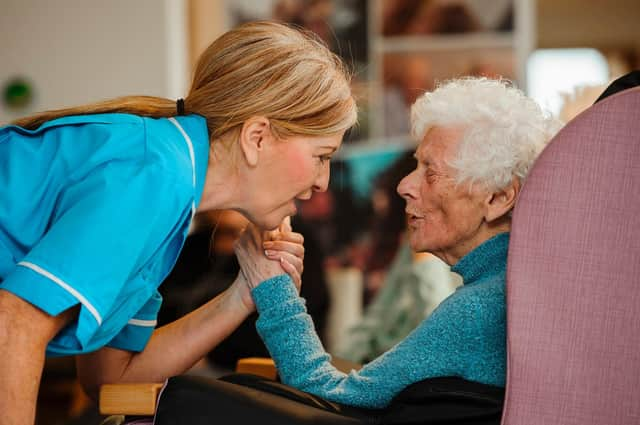Covid-19 has 'exposed the invisibility' of care home residents, says University of Edinburgh report


Care home residents are “invisible” in routine data which has “hampered our understanding” of the Covid-19 pandemic, a report by the University of Edinburgh and NHS Lothian has found.
Findings from the report, which looked specifically at care home data within NHS Lothian, also showed that a small number of larger care homes were more susceptible to outbreaks of coronavirus meaning the majority of the care home sector remains vulnerable to a second wave of the virus.
Advertisement
Hide AdAdvertisement
Hide AdIt also found the likelihood of infection getting into a home tripled with every additional 20 beds, with a total of 419 deaths where Covid-19 was recorded on the death certificate.
The report recommends regular testing, a reliable supply of personal protective equipment and measures to ensure safe staffing as a way to contain any established outbreak.
Author of the report, Professor Bruce Guthrie, said lessons needed to be learned and that “rapid and assertive” infection control is required to minimise the impact of any potential outbreak and that there remained a “large vulnerable population”
He said: “In wave one, many care homes successfully avoided outbreaks or successfully controlled outbreaks. That’s great, but it does mean that there is a large vulnerable population of residents who are at risk in any wave two and we need to make sure that care home outbreaks in any wave two are prevented or kept small.
"The best protection is to stop infection getting into care homes in the first place. More regular testing of staff, and minimising staff working in more than one care home are examples of ways of achieving this which are likely to be important.
"If a resident or member of staff does get infected, then rapid and assertive infection control is needed. This was done in wave one, but better access to Covid testing in wave two should mean that it happens earlier in outbreaks.”
"In the longer term, we need better data about who lives in care homes and the care they get in the care home and from the NHS. COVID-19 has exposed the invisibility of care home residents in data and therefore planning, but that causes problems in normal care case well as for COVID.”
The report added the lack of clear data on care home residents highlighted the “longer-term neglect” of the care sector.
Advertisement
Hide AdAdvertisement
Hide AdIt said: “This has seriously hampered our understanding of the epidemic and its impact, but reflects longer-term neglect of the care sector despite its key role in looking after many of our most vulnerable citizens.
"In the medium term, we need care-home residence to be accurately recorded to support systematic understanding of the needs of a highly vulnerable population.
"Similar issues apply to people receiving social care in their own homes, who are also vulnerable and largely invisible in routine data.”
Professor Guthrie added that the problem is not an NHS Lothian issue. He said: “It’s a sector wide problem across the UK. NHS Lothian was probably ahead of the curve in detecting COVID-19 outbreaks in care homes. That’s because they organised a public health team to go out and test residents early in the epidemic, the first resident test was on March 9, and because there was capacity to test residents in the regional laboratory.
"Like the rest of the UK though, the lack of accessible care home staff testing before mid-April was a major limitation – this was a UK-wide policy decision about who was eligible for testing – on efforts to control spread in care homes.”
Katie Dee, the deputy director of public health and health policy at NHS Lothian, said: “It is important to analyse the risk factors for Covid-19 infection in care homes in order to prevent future outbreaks.”
A message from the Editor:
Thank you for reading this story on our website. While I have your attention, I also have an important request to make of you.
The dramatic events of 2020 are having a major impact on many of our advertisers - and consequently the revenue we receive. We are now more reliant than ever on you taking out a digital subscription to support our journalism.
Advertisement
Hide AdAdvertisement
Hide AdSubscribe to scotsman.com and enjoy unlimited access to Scottish news and information online and on our app. Visit https://www.scotsman.com/subscriptions now to sign up.
Subscribe to the Edinburgh Evening News online and enjoy unlimited access to trusted, fact-checked news and sport from Edinburgh and the Lothians. Visit https://www.edinburghnews.scotsman.com/subscriptions now to sign up.
By supporting us, we are able to support you in providing trusted, fact-checked content for this website.
Joy Yates
Editorial Director
Comments
Want to join the conversation? Please or to comment on this article.